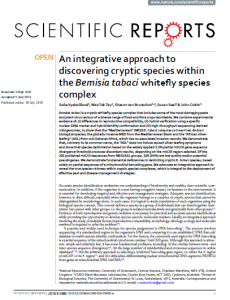Bemisia tabaci is a cryptic whitefly-species complex that includes some of the most damaging pests and plant-virus vectors of a diverse range of food and fibre crops worldwide. We combine experimental evidence of: (i) differences in reproductive compatibility, (ii) hybrid verification using a specific nuclear DNA marker and hybrid fertility confirmation and (iii) high-throughput sequencing-derived mitogenomes, to show that the “Mediterranean” (MED) B. tabaci comprises at least two distinct biological species: the globally invasive MED from the Mediterranean Basin and the “African silver-leafing” (ASL) from sub-Saharan Africa, which has no associated invasion records. We demonstrate that, contrary to its common name, the “ASL” does not induce squash silver-leafing symptoms and show that species delimitation based on the widely applied 3.5% partial mtCOI gene sequence divergence threshold produces discordant results, depending on the mtCOI region selected. Of the 292 published mtCOI sequences from MED/ASL groups, 158 (54%) are low quality and/or potential pseudogenes. We demonstrate fundamental deficiencies in delimiting cryptic B. tabaci species, based solely on partial sequences of a mitochondrial barcoding gene. We advocate an integrative approach to reveal the true species richness within cryptic species complexes, which is integral to the deployment of effective pest and disease management strategies.
Region: Africa, Europe
Date published:
2018
Published by:
Scientific Reports
Type of resource:
Journal article
Resource topic:
Pest control
Project/Programme: Not specific
Pest/Disease: Whitefly
Pages:
13
File type:
External link (2,022 KB)




